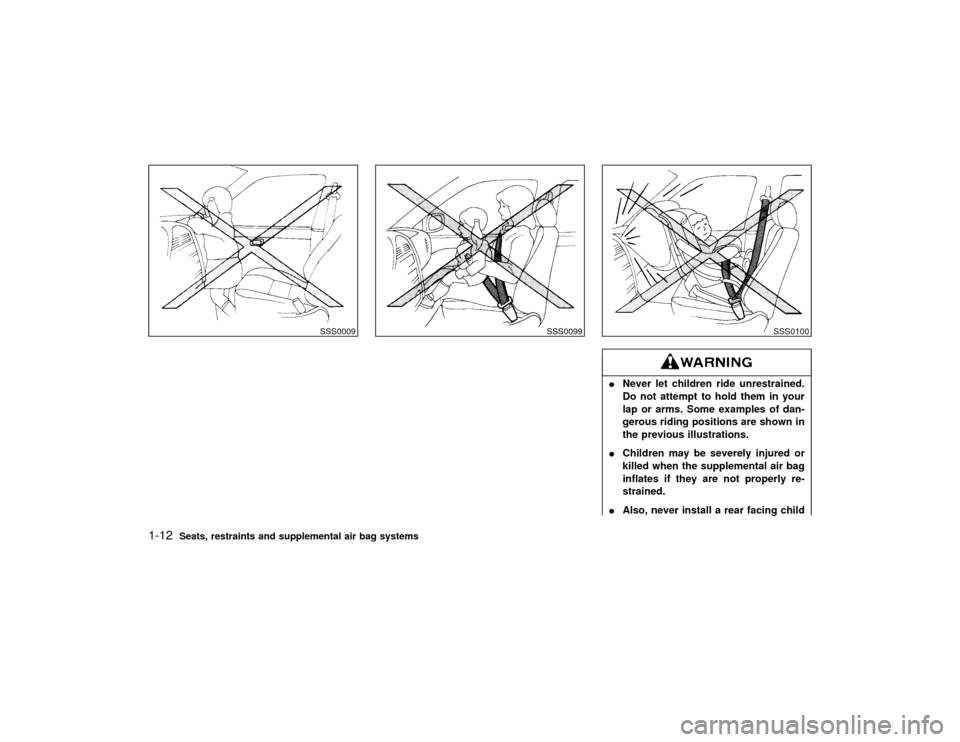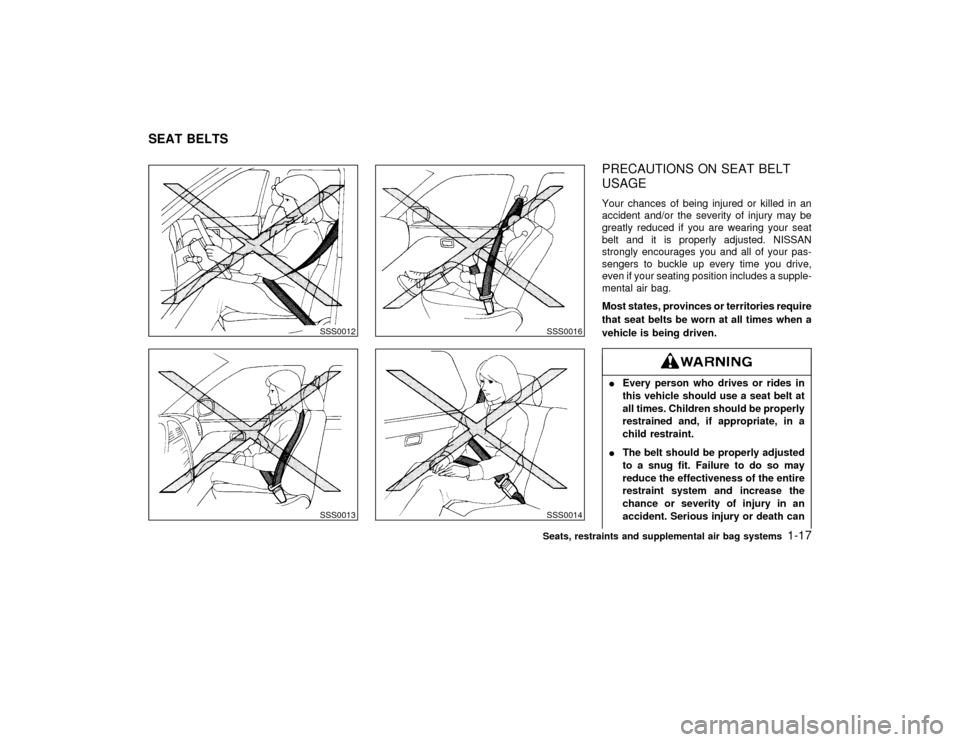1998 NISSAN PATHFINDER child restraint
[x] Cancel search: child restraintPage 1 of 249

ForewordWelcome to the growing family of new NIS-
SAN owners. This vehicle is delivered to you
with confidence. It was produced using the
latest techniques and strict quality control.
This manual was prepared to help you under-
stand the operation and maintenance of your
vehicle so that you may enjoy many miles of
driving pleasure. Please read through this
manual before operating your vehicle.
A separate Warranty Information and Mainte-
nance Log Booklet explains details about the
warranties covering your vehicle and vehicle
maintenance schedules.
Your NISSAN dealer knows your vehicle best.
When you require any service or have any
questions, he will be glad to assist you with
the extensive resources available to him.
READ FIRST Ð THEN DRIVE
SAFELYBefore driving your vehicle please read
your Owner's Manual carefully. This will
ensure familiarity with controls and main-
tenance requirements, assisting you in the
safe operation of your vehicle.IMPORTANT SAFETY INFORMA-
TION
REMINDERS FOR SAFETY!Follow these important driving rules to
help ensure a safe and comfortable
trip for you and your passengers!
INever drive under the influence of
alcohol or drugs.
IAlways observe posted speed limits
and never drive too fast for condi-
tions.
IAlways use your seat belts and ap-
propriate child restraint systems.
Preteen children should be seated
in the rear seat.
IAlways provide information about
the proper use of vehicle safety fea-
tures to all occupants of the vehicle.
IAlways review this Owner's Manual
for important safety information.
For descriptions specified for four wheel drive
models, a
mark is placed at the begin-
ning of the applicable sections/items.
As with other vehicles with features for
offroad use, failure to operate four wheel
drive models correctly may result in loss
of control or an accident. For additional
information, see ªDriving your four wheel
drive safelyº in the ª5. Starting and driv-
ingº section.
ON-PAVEMENT AND OFFROAD
DRIVINGThis vehicle will handle and maneuver
differently from an ordinary passenger
car because it has a higher center of
gravity for offroad use. As with other
vehicles with features of this type, fail-
ure to operate this vehicle correctly may
result in loss of control or an accident.
For additional information, see ªOn-
pavement and offroad driving precau-
tionsº and ªAvoiding collision and roll-
overº in the ª5. Starting and drivingº
section.
Z
01.1.31/R50-D
X
Page 8 of 249

1 Seats, restraints and supplemental air bag
systemsSeats ......................................................................... 1-2
Supplemental restraint system ................................. 1-9
Seat belts ................................................................ 1-17
Child restraints ........................................................ 1-25
Z
01.1.31/R50-D
X
Page 11 of 249

FRONT POWER SEAT
ADJUSTMENTIDo not adjust the driver's seat while
driving in order that full attention may
be given to the driving operations.
IDo not leave children unattended in-
side the vehicle. They could unknow-
ingly activate switches or controls
unattended children could become
involved in serious accidents.Operating tipsIThe motor has an auto-reset overload pro-
tection circuit. If the motor stops during
operation, wait 30 seconds, then reactivate
the switch.
IDo not operate the power support seat for a
long period of time when the engine is off.
This will discharge the battery.
Forward and backwardMoving the switch forward or backward will
slide the seat forward or backward to the
desired position.
RecliningMove the recline switch backward until the
desired angle is obtained. To bring the seat
back forward again, move the switch forward
and move your body forward. The seat back
will move forward.
SPA0463
1-4
Seats, restraints and supplemental air bag systems
Z
01.1.31/R50-D
X
Page 19 of 249

INever let children ride unrestrained.
Do not attempt to hold them in your
lap or arms. Some examples of dan-
gerous riding positions are shown in
the previous illustrations.
IChildren may be severely injured or
killed when the supplemental air bag
inflates if they are not properly re-
strained.
IAlso, never install a rear facing child
SSS0009
SSS0099
SSS0100
1-12
Seats, restraints and supplemental air bag systems
Z
01.1.31/R50-D
X
Page 20 of 249

restraint in the front seat. An inflating
supplemental air bag could seriously
injury or kill your child. See ªSeat
beltsº later in this section for infants
and small children.
Supplemental air bag systemThe driver supplemental air bag is located in
the center of the steering wheel; the front
passenger supplemental air bag is mounted in
the dashboard above the glove box. The
supplemental air bag system is designed to
inflate in higher severity frontal collisions, al-
though it may inflate if the forces in another
type of collision are similar to those of a higher
severity frontal impact. It may not inflate in
certain frontal collisions. Vehicle damage (or
lack of it) is not always an indication of proper
supplemental air bag operation.When the supplemental air bag inflates, a fairly
loud noise may be heard, followed by release
of smoke. This smoke is not harmful and does
not indicate a fire, but care should be taken not
to inhale it, as it may cause irritation and
choking. Those with a history of a breathing
condition should get fresh air promptly.
Supplemental air bags, along with the use of
seat belts, help to cushion the impact force on
the face and chest of the occupant. They can
help save lives and reduce serious injuries.
However, an inflating supplemental air bag
may cause facial abrasions or other injuries.
Supplemental air bags do not provide restraint
to the lower body.
SPA0390B
Seats, restraints and supplemental air bag systems
1-13
Z
01.1.31/R50-D
X
Page 24 of 249

PRECAUTIONS ON SEAT BELT
USAGEYour chances of being injured or killed in an
accident and/or the severity of injury may be
greatly reduced if you are wearing your seat
belt and it is properly adjusted. NISSAN
strongly encourages you and all of your pas-
sengers to buckle up every time you drive,
even if your seating position includes a supple-
mental air bag.
Most states, provinces or territories require
that seat belts be worn at all times when a
vehicle is being driven.IEvery person who drives or rides in
this vehicle should use a seat belt at
all times. Children should be properly
restrained and, if appropriate, in a
child restraint.
IThe belt should be properly adjusted
to a snug fit. Failure to do so may
reduce the effectiveness of the entire
restraint system and increase the
chance or severity of injury in an
accident. Serious injury or death can
SSS0012SSS0013
SSS0016SSS0014
SEAT BELTS
Seats, restraints and supplemental air bag systems
1-17
Z
01.1.31/R50-D
X
Page 25 of 249

occur if the seat belt is not worn
properly.
IAlways route the shoulder belt over
your shoulder and across your chest.
Never run the belt behind your back,
under your arm or across your neck.
The belt should be away from your
face and neck, but not falling off your
shoulder.
IPosition the lap belt as low and snug
as possible AROUND THE HIPS, NOT
THE WAIST. A lap belt worn too high
could increase the risk of internal
injuries in an accident.
IBe sure the seat belt tongue is se-
curely fastened to the proper buckle.
IDo not wear the belt inside out or
twisted. Doing so may reduce its ef-
fectiveness.
IDo not allow more than one person to
use the same belt.
INever carry more people in the ve-
hicle than there are seat belts.
IIf the seat belt warning light glows
continuously while the ignition isturned ON with all doors closed and
all seat belts fastened, it may indicate
a malfunction in the system. Have the
system checked by your NISSAN
dealer.
IAll seat belt assemblies including re-
tractors and attaching hardware
should be inspected after any colli-
sion by your NISSAN dealer. NISSAN
recommends that all seat belt assem-
blies in use during a collision be
replaced unless the collision was mi-
nor and the belts show no damage
and continue to operate properly.
Seat belt assemblies not in use dur-
ing a collision should also be in-
spected and replaced if either dam-
age or improper operation is noted.
CHILD SAFETYChildren need adults to help protect them.
They need to be properly restrained.
The proper restraint depends on the child's
size. Generally, infants (up to about 1 year and
less than 20 lb (9 kg)) should be placed in rear
facing child restraints. Front facing child re-
straints are available for children who outgrowrear facing child restraints.
Infants and children need special pro-
tection. The vehicle's seat belts may not
fit them properly. The shoulder belt may
come too close to the face or neck. The
lap belt may not fit over their small hip
bones. In an accident, an improperly
fitting seat belt could cause serious or
fatal injury. Always use appropriate
child restraints.All US states and provinces of Canada require
the use of approved child restraints for infants
and small children. (See ªChild restraints for
infants and small childrenº later in this section.)
In addition, there are many types of child
restraints available for larger children which
should be used for maximum protection.
NISSAN recommends that all preteens and
children be restrained in the rear seat if
possible. According to accident statistics,
children are safer when properly restrained
in the rear seat than in the front seat. This
is especially important because your ve-
1-18
Seats, restraints and supplemental air bag systems
Z
01.1.31/R50-D
X
Page 26 of 249

hicle has a Supplemental Restraint System
(Air Bag System) for the front passenger
(See ªSupplemental Restraint Systemº ear-
lier in this section for precaution).Infants and small childrenNISSAN recommends that infants and small
children be placed in child restraints that com-
ply with Federal Motor Vehicle Safety Stan-
dards or Canadian Motor Vehicle Safety Stan-
dards. You should choose a child restraint that
fits your vehicle and always follow the manu-
facturer's instructions for installation and use.Larger childrenChildren who are too large for child restraints
should be seated and restrained by the seat
belts which are provided.
If the child's seating position has a shoulder
belt that fits close to the face or neck, the use
of a booster seat (commercially available) may
help overcome this. The booster seat should
raise the child so that the shoulder belt is
properly positioned across the top, middle
portion of the shoulder and the lap belt is low
on the hips. The booster seat should fit the
vehicle seat and have a label certifying that it
complies with Federal Motor Vehicle Safety
Standards or Canadian Motor Vehicle Safety
Standards. Once the child has grown so theshoulder belt is no longer on or near the face
and neck, use the shoulder belt without the
booster seat.
Never let a child stand or kneel on any
seat and do not allow a child in the cargo
areas while the vehicle is moving. The
child could be seriously injured or killed
in an accident.PREGNANT WOMENNISSAN recommends that pregnant women
use seat belts. Contact your doctor for specific
recommendations. The lap belt should be
worn snug and positioned as low as possible
around the hips, not the waist.INJURED PERSONSNISSAN recommends that injured persons
use seat belts, depending on the injury. Check
with your doctor for specific recommendations.
Seats, restraints and supplemental air bag systems
1-19
Z
01.1.31/R50-D
X